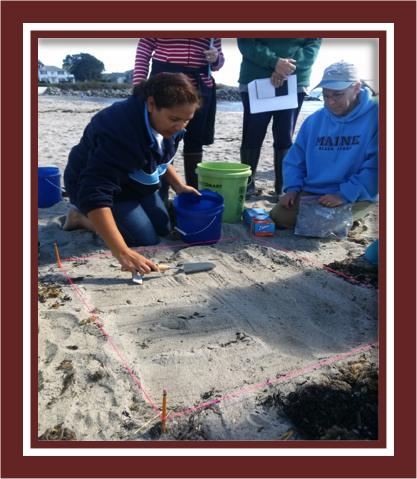The Trashy Side of Plastics: Volunteers Sift Sand in Search of Plastic Fragments Primary tabs

Millions of plastic fragments from styrofoam cups and containers, plastic bags and packaging, cigarette filters, and other sources, are pervasive on our beaches. These debris fragments, known as microplastics, are found throughout the global marine environment. These are small bits of plastic, smaller than the pebbles and seashells, ranging in size from 1 to 5 mm (or less than ¼ inch) and they persist for a very long time in the marine environment.

The persistence of microplastics on beaches and in oceans is a concern. Many marine organisms from zooplankton to whales are indiscriminate eaters, ingesting bits of plastic with their natural food. Once they enter the food web, the indigestible plastic makes its way up the food chain and possibly onto your dinner plate.

Nationally and globally there have been many efforts to gauge just how much microplastic is on coastal beaches, how much is washing up from the open ocean, and how much is coming from land based sources. New Hampshire Sea Grant and UNH Cooperative Extension believe a volunteer, citizen science monitoring program can help find some answers.

New Hampshire beaches have become increasingly popular in the last decade, with Hampton Beach and Jenness Beach being two of the most visited and used beaches in the state, especially during peak summer months. More people on beaches leads to more trash left behind, which breaks down into smaller and smaller pieces over time, with some persisting as microplastics for hundreds of years.
So, in collaboration with the Blue Ocean Society for Marine Conservation (BOS) and Coastal Research Volunteers (CRV) we began a one-year pilot study to detect and quantify microplastic concentrations on New Hampshire beaches. In Fall 2013, teams of CRV and BOS volunteers conducted 3 sampling “blitzes” on 8 beaches in October, April and September. Collectively the 35 volunteers gathered 324 gallons of sand, which contained 1,305 microplastic pieces. From this beach sampling, we estimated that more than 5 million pieces of microplastic were present on our beaches. As a result of this first of its kind pilot study on New Hampshire beaches, we were able to determine the top three most impacted beaches, and regardless of beach or time of year, foams and plastic fragments were the most prevalent source of microplastic debris.
Sampling beaches and sorting hundreds of gallons of sand looking for small pieces of plastic could not be done without the help of our volunteers. Microplastic volunteer Rebecca Potter says, ““I appreciated the opportunity of being on the ground floor of the microplastics research and learning about the intricacies of gathering research data. It's a tedious process, but I had fun being at the beach, digging in the sand, and spending time with the other volunteers and Gabby. Hopefully the results from the study will assist in educating people of the importance of disposing plastic products responsibly and keeping plastics out of the oceans and beaches.”

These aren’t easy and quick sampling protocols, but it is important that we do this work, to gauge the health and safety of our beaches. Plastics never go away, they can be ingested by everything from the smallest insect to human babies playing in the sand. To stem the flow of plastics into our marine environments, we need to understand where and how these micro-pollutants are accumulating.
The New Hampshire microplastics beach monitoring project begins its second year of sampling in a few short weeks, as soon as the beaches are clear and the weather permits. Please join us. Watch for upcoming beach microplastics training. Get ready to hit the beach and collect some sand!